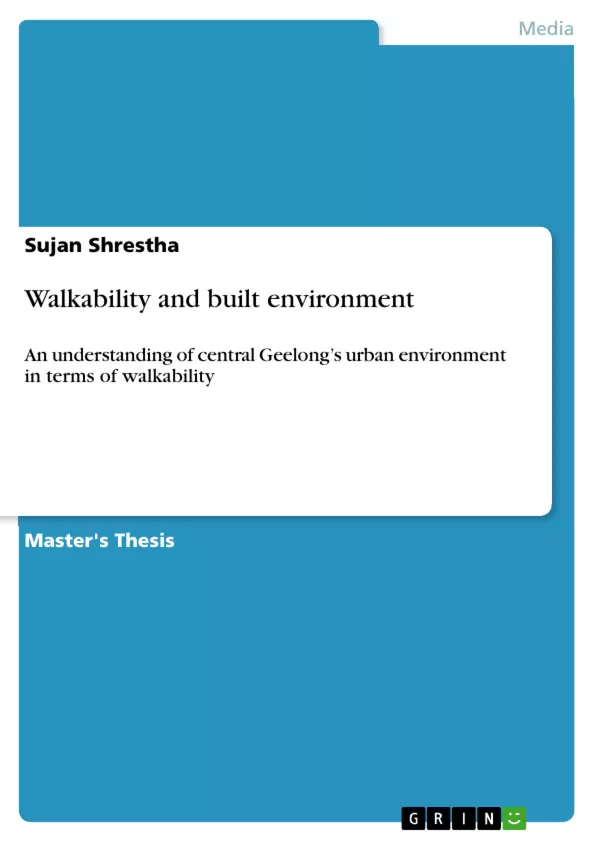Car-centric urban design practice, the principle with which most cities in the world are being built today or since mid-century of 20th century, is affecting the essence of human-scale design or pedestrian friendly/ walkable friendly design. With the rise of numerous problems already in the world with excessive use of non-renewable energy, the talks and discussions are being conducted for the ways of reduction of use of non-renewable energy on global basis, or for the formulation of alternative ways of high use of energy. Not only from problems-related-with-energy perspective, but from social, health, and economic viewpoint as well, just prioritising car-driven approach seems to no longer serve the built environment in a positive way. Several planners, designers and built environment professionals have put forwarded words to re-think about the way urban environments are being built today, and new approaches of prioritising from human-scale perspective i.e. pedestrian or walkable friendly built environment to be explored and given a thought. This research paper concentrates on investigating the deeper understanding about walkable friendly urban environment, the need of today's world.
In this paper, framework that shows the relationship of walking activity and behaviour with surrounding physical features, is derived from literature review for the systematic visual assessment. There is no clear and a comprehensive understanding about one particular way that depicts influencing factors of walkability, the corelates between the urban environment and walking behaviour not explained clearly, or if explained the method is somewhat complex and inflexible. Throughout existing knowledge in literature, there is lack of one consistent method of assessment. This research has attempted in finding simpler methods/solution, incorporating with existing knowledge and methods to investigate underlying factors possibly informing about the degree of walkability scale of an urban environment. The study of observation is done on the commercial streets in the central Geelong with the selection of variety of streets form and functions.
Inhaltsverzeichnis (Table of Contents)
- Abstract
- Acknowledgements
- Table of Contents
- Chapter 1. Introduction
- 1.1. Background
- 1.2. Walkability: The definition
- 1.3. Aims and objectives
- 1.4. Research significance
- 1.5. Methodology
- Chapter 2. Walkability: Relation and context
- 2.1. Walking and the built environment
- 2.2. Benefits of walkability
- 2.3. Geelong's past vision
- 2.4. Geelong's approaches: Walkable friendly environment
- Chapter 3. Literature review
- 3.1. Background
- 3.2. Analysis and synthesis
- 3.3. Literature review matrix
- Chapter 4. Empirical study
- 4.1. Observation study: Description of method and data
- 4.2. Serial Vision
- 4.3. Quantitative evaluation
- 4.4. Qualitative evaluation
- 4.5. Observation study: Results and analysis
- Chapter 5. Discussion and Conclusion
- 5.1. Discussion
Zielsetzung und Themenschwerpunkte (Objectives and Key Themes)
This research paper investigates the concept of walkability in the urban environment, with a focus on central Geelong. It explores the relationship between walking activity and behavior with surrounding physical features. The study aims to understand the need for walkable-friendly urban environments in today's world and to develop a comprehensive framework for assessing walkability.
- The need for a shift from car-centric urban design to human-scale, pedestrian-friendly environments
- The benefits of walkability in terms of energy use, social, health, and economic aspects
- The development of a comprehensive framework for assessing walkability
- The application of the framework in the study of central Geelong's commercial streets
- The exploration of the relationship between people's perceptions and the built environment
Zusammenfassung der Kapitel (Chapter Summaries)
- Chapter 1: Introduction - This chapter introduces the research topic, provides background information on the current state of urban design, and defines walkability. It also outlines the research aims, objectives, significance, and methodology.
- Chapter 2: Walkability: Relation and context - This chapter explores the relationship between walking and the built environment, discusses the benefits of walkability, and examines Geelong's past vision and approaches to walkable-friendly environments.
- Chapter 3: Literature review - This chapter provides a comprehensive review of existing literature on walkability, its assessment methods, and related research.
- Chapter 4: Empirical study - This chapter presents the results of an observational study conducted in central Geelong, utilizing a method combining qualitative and quantitative evaluation. The study aims to investigate the connection between the built environment and walkability.
- Chapter 5: Discussion and Conclusion - This chapter discusses the findings of the empirical study and explores their implications for urban planning and design in relation to walkability. It also provides a concluding statement about the research.
Schlüsselwörter (Keywords)
This research paper focuses on the concept of walkability, exploring its definition, assessment methods, and its relationship with the built environment. It examines the challenges of car-centric urban design and the benefits of creating pedestrian-friendly environments. Key themes include urban regeneration, walkable-friendly urban design, and the application of a systematic approach to assess walkability through the study of central Geelong.
- Quote paper
- Sujan Shrestha (Author), 2020, Walkability and built environment, Munich, GRIN Verlag, https://www.grin.com/document/911552



